CSDN话题挑战赛第2期
参赛话题:学习笔记
学习之路,长路漫漫,写学习笔记的过程就是把知识讲给自己听的过程。这个过程中,我们去记录思考的过程,便于日后复习,梳理自己的思路。学习之乐,独乐乐,不如众乐乐,把知识讲给更多的人听,何乐而不为呢?
目录
1、Spring框架概述
1.1、Spirng是轻量级的开源的JavaEE框架
1.2、Spring可以解决企业应用开发的复杂性
1.3、Spirng有两个核心部分:IOC和AOP
(1) IOC:控制反转,把创建对象过程交给Spring进行管理
(2) AOP:面向切面,不修改源代码进行功能增强
1.4、Spring特点
- 方便解耦,简化开发
- AOP编程支持
- 方便程序测试
- 方便和其他框架进行整合
- 方便进行事务操作
- 降低API开发难度
2、Spring入门案例
- 1、先下载spring5 https://repo.spring.io/ui/native/release/org/springframework/spring/
- 2、打开idea工具,创建普通的maven工程
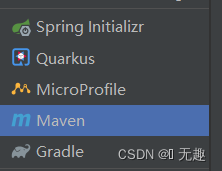
- 3、在maven里面创建简单Java模块


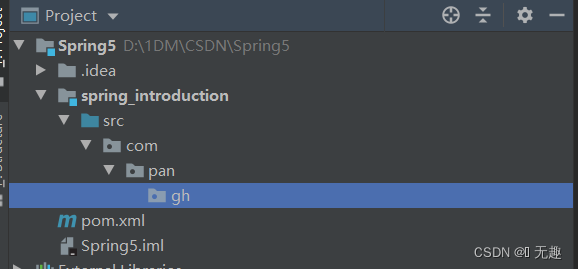
- 4、导入spring相关的包

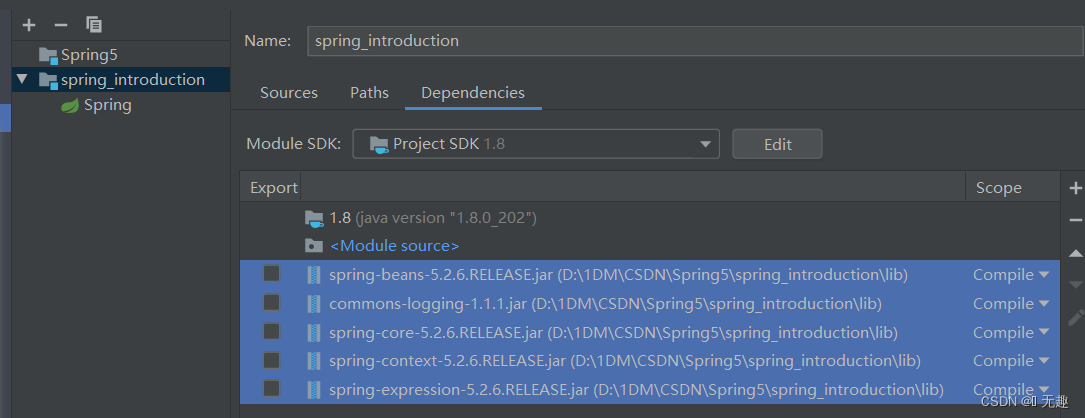

- 5、创建普通类,在这个类创建普通方法
/**
* @User: 老潘
* @date 2022年09月28日10:44
*/
public class Student {
public void add(){
System.out.println("add......bean.xml");
}
}
- 6、创建Spring配置文件,在配置文件配置创建的对象
注意bean.xml文件的位置:
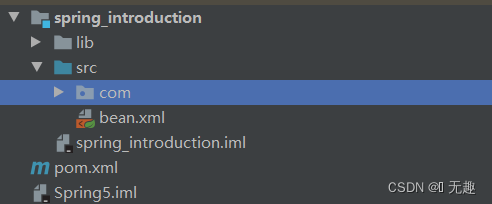
<?xml version="1.0" encoding="UTF-8"?>
<beans xmlns="http://www.springframework.org/schema/beans"
xmlns:xsi="http://www.w3.org/2001/XMLSchema-instance"
xsi:schemaLocation="http://www.springframework.org/schema/beans http://www.springframework.org/schema/beans/spring-beans.xsd">
<!--配置Student对象创建-->
<bean id="student" class="com.pan.gh.Student"></bean>
</beans>- 7、进行测试代码编写
/**
* @User: 老潘
* @date 2022年09月28日10:50
*/
public class testSpring {
@Test
public void testAdd(){
//1、加载spring配置文件
ApplicationContext context=
new ClassPathXmlApplicationContext("bean.xml");
//2、获取配置创建的对象
Student student=context.getBean("student",Student.class);
System.out.println(student);
student.add();
}
}
运行结果:
com.pan.gh.Student@3d921e20
add......bean.xml
3、IOC
3.1、IOC(概念和原理)
3.1.1、什么是IOC
- 控制反转,把对象创建和对象之间的调用过程,交给Spring进行管理
- 使用IOC目的,为了耦合度降低
- 做入门案例就是IOC的具体实现
3.1.2、IOC底层原理
1)xml解析、工厂模式、反射
2)讲解IOC底层原理
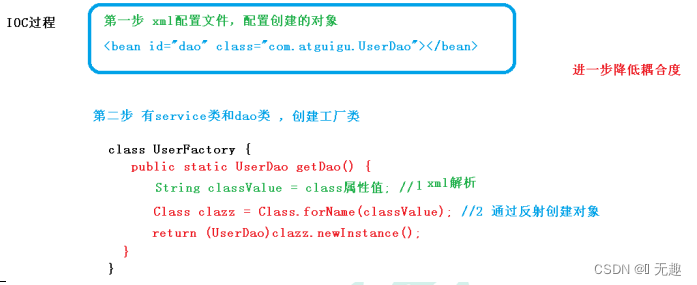
3) IOC(BeanFactory 接口)
1、IOC 思想基于 IOC 容器完成,IOC 容器底层就是对象工厂
2、Spring 提供 IOC 容器实现两种方式:(两个接口)
(1)BeanFactory:IOC 容器基本实现,是 Spring 内部的使用接口,不提供开发人员进行使用
* 加载配置文件时候不会创建对象,在获取对象(使用)才去创建对象
(2)ApplicationContext:BeanFactory 接口的子接口,提供更多更强大的功能,一般由开发人 员进行使用 * 加载配置文件时候就会把在配置文件对象进行创建 3、 ApplicationContext 接口有实现类

3.2、IOC操作Bean管理(概念)
3.2.1、什么是Bean管理
1)Bean管理指的是两个操作
2)Spring创建对象
3)Spring注入属性
3.2.2、Bean管理操作有两种方式
1)基于XML配置文件方式实现
2)基于注解方式实现
3.3、IOC操作Bean管理(基于XML方式)
3.3.1、基于xml方式创建对象
<!--配置Student对象创建-->
<bean id="student" class="com.pan.gh.Student"></bean>
1)在spring配置文件中,使用bean标签,标签里面添加对应属性,就可以实现对象创建
2)在bean标签有很多属性,介绍常用的属性
* id属性:唯一标识(一般为类的小写)
* class属性:类路径名称(包含路径)
3)创建对象时候,默认也是执行无参构造方法完成对象创建
3.3.2、基于xml方式注入属性
1)DI:依赖注入,就是注入属性
3.3.3、第一种注入方式:使用set方式进行注入
1)创建类,定义属性和对应的set方法
/**
* @User: 老潘
* @date 2022年09月28日19:36
* 演示使用set方法进行注入属性
*/
public class Book {
// 创建属性
private String bname;
private String bauthor;
// 创建属性对应的set方法
public void setBname(String bname){
this.bname=bname;
}
public void setBauthor(String bauthor) {
this.bauthor = bauthor;
}
public void testB(){
System.out.println(bname+"::"+bauthor);
}
}2)在spring配置文件中配置对象,配置属性注入
<?xml version="1.0" encoding="UTF-8"?>
<beans xmlns="http://www.springframework.org/schema/beans"
xmlns:xsi="http://www.w3.org/2001/XMLSchema-instance"
xsi:schemaLocation="http://www.springframework.org/schema/beans http://www.springframework.org/schema/beans/spring-beans.xsd">
<!--2、set方法注入属性-->
<bean id="book" class="com.pan.gh.Book">
<!--使用property完成属性注入
name:类里面属性名称
value:向属性注入的值
-->
<property name="bname" value="葵花宝典"></property>
<property name="bauthor" value="隔壁老王"></property>
</bean>
</beans>3)测试结果
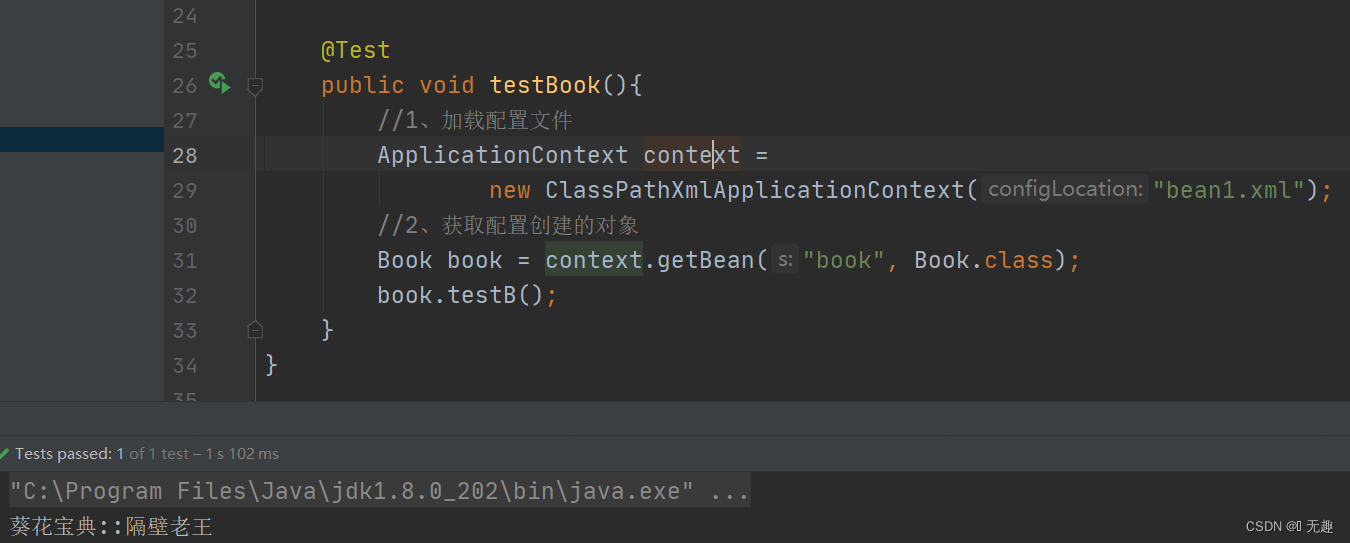
3.3.4、第二种注入方式:使用有参数构造进行注入
1)创建类,定义属性:创建属性对应有参构造方法
/**
* @User: 老潘
* @date 2022年09月28日19:47
* 使用有参构造注入
*/
public class Order {
// 属性
private String oname;
private String address;
// 有参构造
public Order(String oname, String address) {
this.oname = oname;
this.address = address;
}
public void testO(){
System.out.println(oname+"::"+address);
}
}2)在spring配置文件中进行配置
<?xml version="1.0" encoding="UTF-8"?>
<beans xmlns="http://www.springframework.org/schema/beans"
xmlns:xsi="http://www.w3.org/2001/XMLSchema-instance"
xsi:schemaLocation="http://www.springframework.org/schema/beans http://www.springframework.org/schema/beans/spring-beans.xsd">
<!--2、有参构造注入属性-->
<bean id="order" class="com.pan.gh.Order">
<constructor-arg name="oname" value="电脑"></constructor-arg>
<constructor-arg name="address" value="中国"></constructor-arg>
</bean>
</beans>3)测试结果
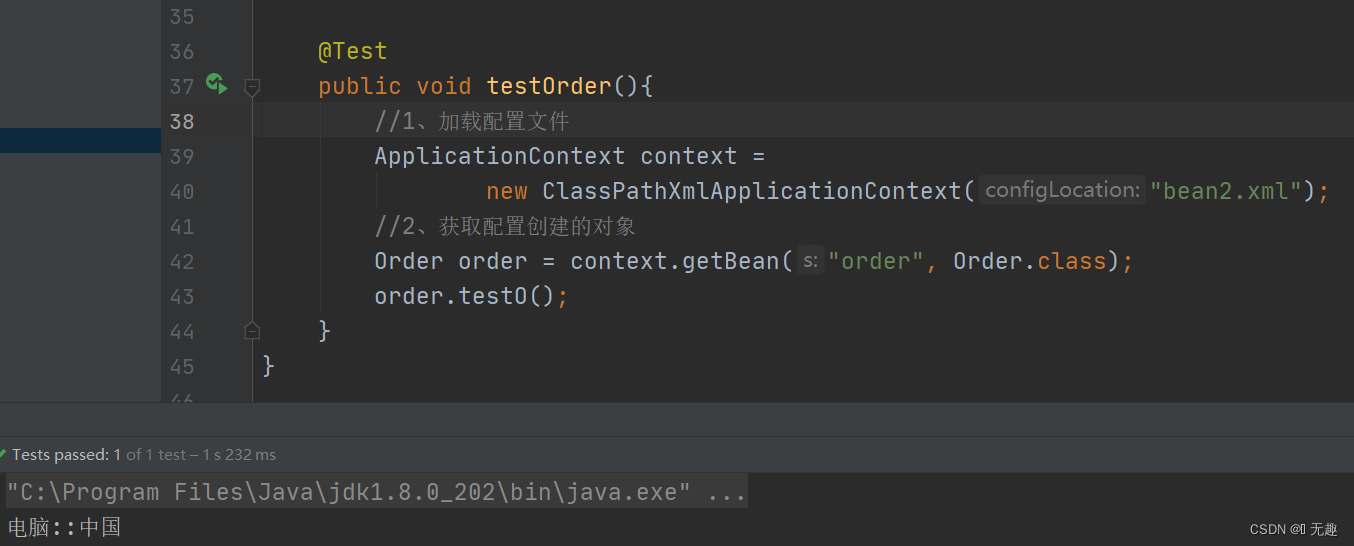
3.3.5、p名称空间注入(了解)
1)使用p名称空间注入,可以简化基于xml配置方式
第一步 添加p名称空间在配置文件中:
<beans xmlns="http://www.springframework.org/schema/beans"
xmlns:xsi="http://www.w3.org/2001/XMLSchema-instance"
xmlns:p="http://www.springframework.org/schema/p"
xsi:schemaLocation="http://www.springframework.org/schema/beans http://www.springframework.org/schema/beans/spring-beans.xsd">
第二步 进入属性注入,在bean标签里面进行操作
<!--2、set方法注入属性-->
<bean id="book" class="com.pan.gh.Book" p:bname="九阳神功" p:bauthor="无名氏">
</bean>第三步 结果测试

4、IOC操作Bean管理(xml注入其他类型属性)
4.1、字面量
- null值
<!--null值-->
<property name="address">
<null/>
</property>- 属性值包含特殊符号
<?xml version="1.0" encoding="UTF-8"?>
<beans xmlns="http://www.springframework.org/schema/beans"
xmlns:xsi="http://www.w3.org/2001/XMLSchema-instance"
xsi:schemaLocation="http://www.springframework.org/schema/beans http://www.springframework.org/schema/beans/spring-beans.xsd">
<!--2、有参构造注入属性-->
<bean id="school" class="com.pan.gh.School">
<!-- <property name="address">-->
<!-- <null/>-->
<!-- </property>-->
<!--属性值包含特殊符号:
1、把<>进行转义 < >
2、把带特殊符号内容写到CDATA-->
<property name="name" value="江西"></property>
<property name="address">
<value><![CDATA[<<南京>>]]></value>
</property>
</bean>
</beans>4.2、注入属性--外部bean
1)创建两个类UserService和UserDao类
2)在UserService调用UserDao里面的方法
3)在spring配置文件中进行配置
/**
* @User: 老潘
* @date 2022年09月28日20:28
*/
public class UserService {
// 创建UserDao类型属性,生成set方法
private UserDao userDao;
public void setUserDao(UserDao userDao) {
this.userDao = userDao;
}
public void add(){
System.out.println("service add.......");
userDao.update();
}
}
/**
* @User: 老潘
* @date 2022年09月28日20:29
*/
public class UserDaoImpl implements UserDao{
@Override
public void update() {
System.out.println("UserDao接口方法重写");
}
}
<?xml version="1.0" encoding="UTF-8"?>
<beans xmlns="http://www.springframework.org/schema/beans"
xmlns:xsi="http://www.w3.org/2001/XMLSchema-instance"
xsi:schemaLocation="http://www.springframework.org/schema/beans http://www.springframework.org/schema/beans/spring-beans.xsd">
<!--1、service和dao对象创建-->
<bean id="userService" class="com.pan.gh.outBean.UserService">
<!--注入userDao对象
name属性:类里面属性名称
ref属性:创建userDao对象bean标签id值
-->
<property name="userDao" ref="userDaoImpl"></property>
</bean>
<bean id="userDaoImpl" class="com.pan.gh.outBean.UserDaoImpl"></bean>
</beans>运行结果

4.3、注入属性 -- 内部bean
1)一对多关系:班级和学生
一个班级有多个学生,一个学生属于一个班级 班级是一 ,学生是多
2) 在实体类之间表示一对多关系,学生表示所属班级,使用对象类型属性进行表示
3) 在spring配置文件中进行配置
/**
* @User: 老潘
* @date 2022年09月28日20:42
*/
public class Student {
private String sname;
public void setSname(String sname) {
this.sname = sname;
}
public String getSname() {
return sname;
}
}
/**
* @User: 老潘
* @date 2022年09月28日20:42
*/
public class ClassRoom {
private String cname;
private String gender;
// 学生属于某一个班级,使用对象形式表示
private Student student;
public void setCname(String cname) {
this.cname = cname;
}
public void setGender(String gender) {
this.gender = gender;
}
public void setStudent(Student student) {
this.student = student;
}
public void testRM(){
System.out.println(cname+"::几年级:"+gender+"::学生名字为:"+student.getSname());
}
}
<?xml version="1.0" encoding="UTF-8"?>
<beans xmlns="http://www.springframework.org/schema/beans"
xmlns:xsi="http://www.w3.org/2001/XMLSchema-instance"
xsi:schemaLocation="http://www.springframework.org/schema/beans http://www.springframework.org/schema/beans/spring-beans.xsd">
<!--内部bean-->
<bean id="classRoom" class="com.pan.gh.inBean.ClassRoom">
<!--设置两个普通属性-->
<property name="cname" value="6班"></property>
<property name="gender" value="高一"></property>
<!--设置对象类型属性-->
<property name="student">
<bean id="student" class="com.pan.gh.inBean.Student">
<property name="sname" value="苏幕"></property>
</bean>
</property>
</bean>
</beans>测试结果

4.4、注入属性--级联赋值
<?xml version="1.0" encoding="UTF-8"?>
<beans xmlns="http://www.springframework.org/schema/beans"
xmlns:xsi="http://www.w3.org/2001/XMLSchema-instance"
xsi:schemaLocation="http://www.springframework.org/schema/beans http://www.springframework.org/schema/beans/spring-beans.xsd">
<!--内部bean-->
<bean id="classRoom" class="com.pan.gh.inBean.ClassRoom">
<!--设置两个普通属性-->
<property name="cname" value="6班"></property>
<property name="gender" value="高一"></property>
<!--设置对象类型属性-->
<property name="student" ref="student">
</property>
</bean>
<bean id="student" class="com.pan.gh.inBean.Student">
<property name="sname" value="苏幕"></property>
</bean>
</beans>4.5、注入属性--集合属性
4.5.1、注入数组类型属性
4.5.2、注入List集合类型属性
4.5.3、注入Map集合类型属性
- 创建类,定义数组、list、map、set类型属性,生成对应set方法
public class Stu {
//1 数组类型属性
private String[] courses;
//2 list 集合类型属性
private List<String> list;
//3 map 集合类型属性
private Map<String,String> maps;
//4 set 集合类型属性
private Set<String> sets;
public void setSets(Set<String> sets) {
this.sets = sets;
}
public void setCourses(String[] courses) {
this.courses = courses;
}
public void setList(List<String> list) {
this.list = list;
}
public void setMaps(Map<String, String> maps) {
this.maps = maps;
}
}
-
在spring配置文件进行配置
<?xml version="1.0" encoding="UTF-8"?>
<beans xmlns="http://www.springframework.org/schema/beans"
xmlns:xsi="http://www.w3.org/2001/XMLSchema-instance"
xsi:schemaLocation="http://www.springframework.org/schema/beans http://www.springframework.org/schema/beans/spring-beans.xsd">
<!--1 集合类型属性注入-->
<bean id="stu" class="com.pan.gh.Stu">
<!--数组类型属性注入-->
<property name="courses">
<array>
<value>java 课程</value>
<value>数据库课程</value>
</array>
</property>
<!--list 类型属性注入-->
<property name="list">
<list>
<value>张三</value>
<value>小三</value>
</list>
</property>
<!--map 类型属性注入-->
<property name="maps">
<map>
<entry key="JAVA" value="java"></entry>
<entry key="PHP" value="php"></entry>
</map>
</property>
<!--set 类型属性注入-->
<property name="sets">
<set>
<value>MySQL</value>
<value>Redis</value>
</set>
</property>
</bean>
</beans>4.5.4、在集合里面设置对象类型值
<!--创建多个 course 对象-->
<bean id="course1" class="com.atguigu.spring5.collectiontype.Course">
<property name="cname" value="Spring5 框架"></property>
</bean>
<bean id="course2" class="com.atguigu.spring5.collectiontype.Course">
<property name="cname" value="MyBatis 框架"></property>
</bean>
<!--注入 list 集合类型,值是对象-->
<property name="courseList">
<list>
<ref bean="course1"></ref>
<ref bean="course2"></ref>
</list>
</property>
4.5.5、把集合注入部分提取出来
(1)在 spring 配置文件中引入名称空间 util
<?xml version="1.0" encoding="UTF-8"?>
<beans xmlns="http://www.springframework.org/schema/beans"
xmlns:xsi="http://www.w3.org/2001/XMLSchema-instance"
xmlns:p="http://www.springframework.org/schema/p"
xmlns:util="http://www.springframework.org/schema/util"
xsi:schemaLocation="http://www.springframework.org/schema/beans
http://www.springframework.org/schema/beans/spring-beans.xsd
http://www.springframework.org/schema/util
http://www.springframework.org/schema/util/spring-util.xsd">
(2)使用 util 标签完成 list 集合注入提取
<!--1 提取 list 集合类型属性注入-->
<util:list id="bookList">
<value>易筋经</value>
<value>九阴真经</value>
<value>九阳神功</value>
</util:list>
<!--2 提取 list 集合类型属性注入使用-->
<bean id="book" class="com.atguigu.spring5.collectiontype.Book">
<property name="list" ref="bookList"></property>
</bean>







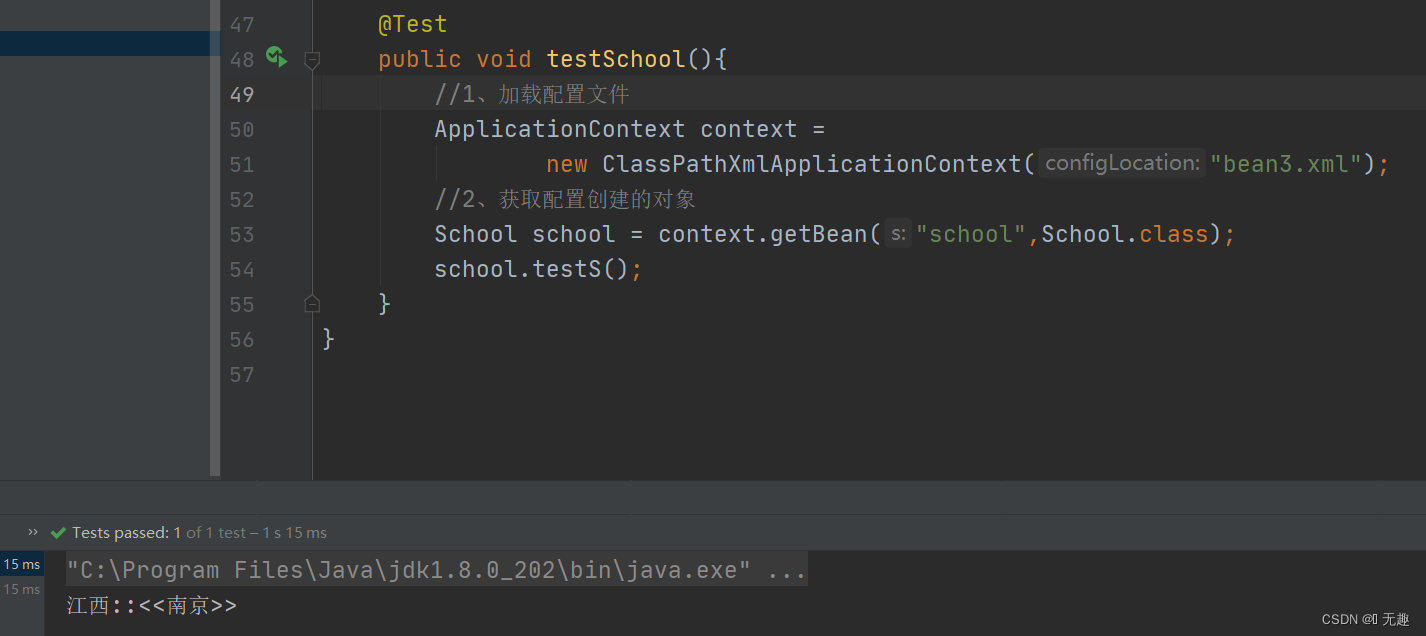














 1270
1270











 被折叠的 条评论
为什么被折叠?
被折叠的 条评论
为什么被折叠?








